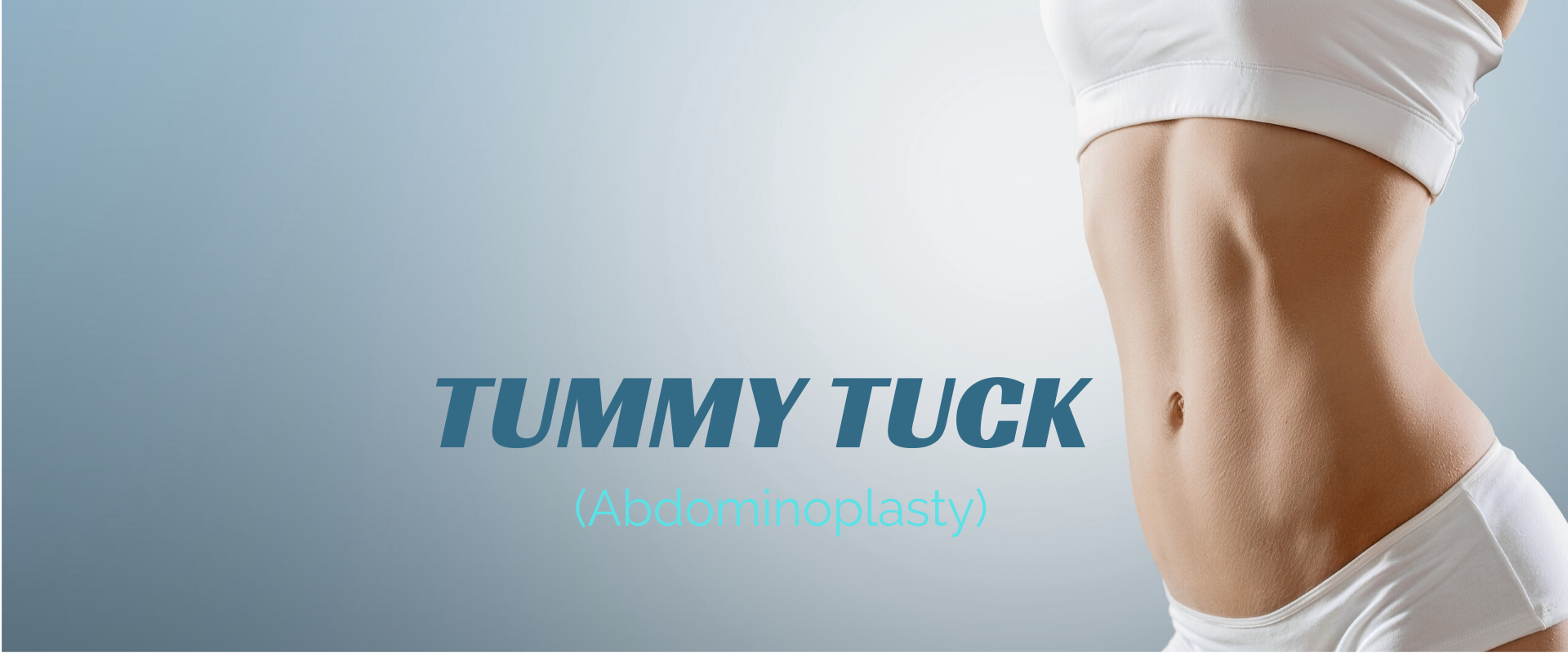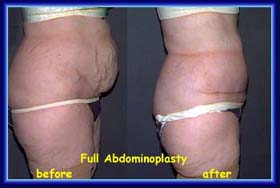
The Tummy Tuck: Removing excess skin. Tightening abdominal muscles.
The tummy tuck is an operation that is designed to remove excess skin from the abdomen while usually, at the same time, tightening the abdominal muscles. It is indicated in cases where there is laxity of the abdomen resulting in bulging due to abnormal stretching of the abdominal muscles and skin. Unlike liposuction surgery, which just removes fat, this operation involves removal of skin and fat, with tightening of the abdominal muscles. For this reason, it is more extensive than liposuction. The actual extent of surgery will depend on the amount of excess skin and the laxity of the abdominal muscles.

In some cases, liposuction surgery can be combined with excision of excess abdominal skin instead of a more complete tummy tuck (see article on liposuction). When a full tummy tuck is contemplated, however, extensive liposuction of the abdomen is best delayed until a later time, since there seems to be a higher chance of complications when extensive liposuction is combined with abdominoplasty. Liposuction of other body areas can be combined. Not uncommonly, “touch up” liposuction may be done later under local anesthesia following the original operation. We usually recommend waiting at least six months before this touch up is accomplished.
For patients with bulging muscle and excess fat, whose skin is relatively tight, an endoscopic abdominoplasty is an option that can be considered. It is discussed below.
Prior to Tummy Tuck Surgery
Prior to tummy tuck surgery, markings are made on the skin outlining the site of incision and other significant landmarks. The operation is carried out under general anesthesia. An incision is made in the bikini line and the excess skin is pulled down and inward, and is removed along with underlying fatty tissue. The muscles are tightened as required, the skin is carefully redraped, and the incision is carefully closed with several layers of suture. The belly button will have to be repositioned because of the amount of skin removed. Contrary to what you may think, the belly button is not removed during the operation!
 Following surgery, a compressive girdle and stockings are worn for a while. There may be considerable discomfort for several days following surgery but most patients resume limited activity in a day or so. A urinary catheter is normally left in place for several hours after surgery, and wound drains are kept in place for a few days to help prevent the accumulation of fluid.
Following surgery, a compressive girdle and stockings are worn for a while. There may be considerable discomfort for several days following surgery but most patients resume limited activity in a day or so. A urinary catheter is normally left in place for several hours after surgery, and wound drains are kept in place for a few days to help prevent the accumulation of fluid.
A recent innovation is the use of a “pain pump.” This is a very small catheter that is inserted along side the drain tube, which is attached to a small pump that instills a local anesthetic solution into the wound for a few days following surgery. Because of the risk of possible pulmonary emboli or partial lung collapse, it is important for patients to begin movement promptly after surgery even if it is uncomfortable. The use of a pain pump makes it easier for patients to begin moving about promptly after surgery.
Because of the extent of the surgery, there are risks involved, which can result in serious complications. Infection or collections of blood or fluid in the wound may delay recovery and could result in skin loss, fat necrosis or scarring. These could lead to the need for additional corrective surgery. The abdominal wall is stretched during surgery and the blood supply to the skin may be damaged. This may lead to loss of skin. If this happens patients from out of town may require referral to a specialized wound care center for treatment. This could possibly involve significant extra expense that may not be covered by insurance.
Fortunately, most tummy tucks are uncomplicated, but patients must be prepared for the added time needed for recovery when complications occur.
In addition, patients must realize that there is a sizable scar, which, although hidden, may thicken or widen, possibly requiring later revision. It is also important to realize that it will take many months for the scar to fade to its final appearance. Unfortunately, because of the pull involved with the operation, it is not uncommon for scars to be somewhat widened or irregular.
Tummy Tucks are Gratifying
In spite of these considerations, the operation is generally very gratifying. Many patients realize relief of functional symptoms such as low back pain, rash and abdominal discomfort following the surgery. In fact, tummy tucks are, perhaps, the fastest growing procedure at our Center.
We are doing two to three times the number that we did a decade ago.
Tummy tucks are carried out in our Outpatient Surgical Center. If patients choose to have surgery on an outpatient basis, they must understand that if any complications develop, hospitalization could possibly be required and could involve additional cost, which may not be covered by insurance. Although a more major procedure than liposuction surgery, in many cases, abdominoplasty will provide the type of contour improvement that patients are seeking, which cannot be provided by other means.
ENDOSCOPIC ABDOMINOPLASTY
 While abdominoplasty remains a popular option for women with excess abdominal skin and fat combined with muscular laxity, admittedly it is an extensive surgical procedure. Patients must be prepared for a few weeks of recovery and be willing to accept a long scar that is a necessary part of the surgical procedure.
While abdominoplasty remains a popular option for women with excess abdominal skin and fat combined with muscular laxity, admittedly it is an extensive surgical procedure. Patients must be prepared for a few weeks of recovery and be willing to accept a long scar that is a necessary part of the surgical procedure.
Certainly, many patients who formerly considered abdominoplasty now obtain satisfactory results from liposuction surgery alone, but fat suctioning does nothing to tighten up the abdominal muscles. A gap has existed between candidates for liposuction surgery alone and those who need either a full abdominoplasty or abdominoplasty combined with liposuction surgery. The endoscopic abdominoplasty can fill this gap. The operation involves a tightening of the abdominal muscles through an endoscopic approach.
Like all endoscopic procedures, this type of abdominoplasty can really be considered Band-Aid surgery. Working entirely through tiny incisions often limited to a single incision around the belly button, we can tighten up the abdominal muscles by suturing with special instruments, while viewing through telescopes and cameras that are designed for the job. It is applicable for patients with moderate to mild muscle bulging, primarily in patients who have not had previous major surgery of the abdomen.
Endoscopic abdominoplasty is not commonly the procedure of choice but may be applicable in certain cases. Recovery is generally very prompt. In fact most patients resume relatively normal activity within a few days. Discomfort is somewhat more than liposuction alone, but usually does not interfere with normal activity after a week or so. Surgical drains are required for a few days to prevent accumulation of fluid that can sometimes occur. If fluid builds up after the drains are removed, it may require removal by aspiration with a syringe. We have seen few other complications, although bleeding and infection are possible. During your consultation we will review any additional risks or complications that may have arisen. Our experience with the endoscopic abdominoplasty has been very favorable in a small select number of patients seeking abdominoplasty.
MODIFIED ABDOMINOPLASTY
Traditional abdominoplasty involves a long transverse incision running from hip to hip. All of the skin between the belly button and the incision is removed. In some cases, less extensive resection is possible, resulting in a somewhat shorter scar. If this type of approach appears suitable, it will be discussed during your consultation. Not infrequently we will carry out full liposuction of the abdomen and excise a crescent of lower abdominal skin. While there is still a long lower abdominal scar, risk is reduced since we do not elevate the skin or address muscular laxity. •

